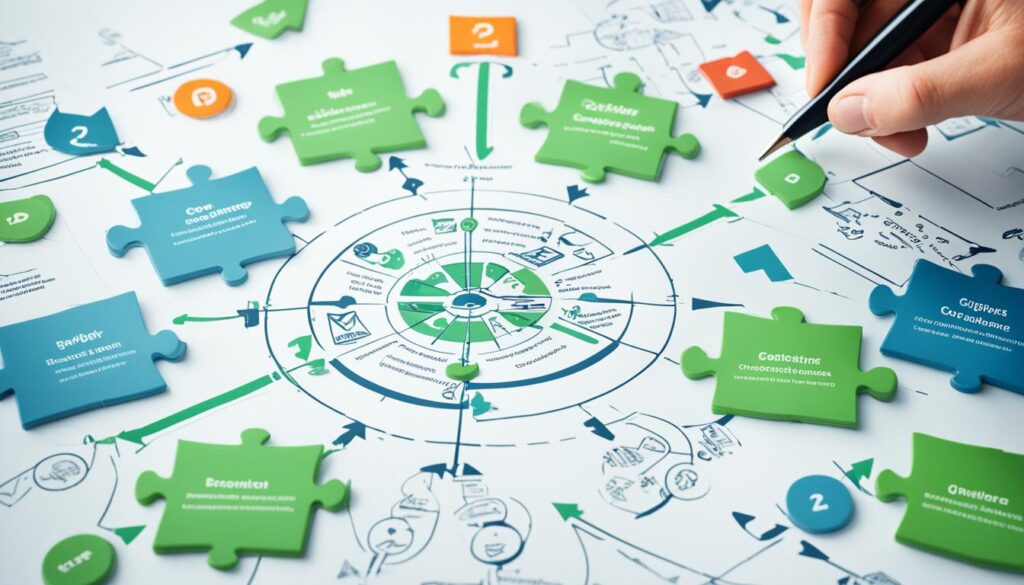One of the biggest challenges in B2B content marketing is creating content that feels relatable and engaging. Often, B2B content can come across as impersonal and devoid of the human touch. However, connecting with your audience on a human level is crucial for building meaningful relationships and driving conversions. To help you humanize your B2B content, here are five valuable tips:
1. Understand Your Audience’s Motivations: Take the time to delve deeper into your audience’s emotions and contextual drivers. By knowing why they make certain buying decisions, you can create content that resonates with their motivations. This will help you establish a stronger connection and generate more meaningful engagements. For example, if your target audience consists of practice managers, understand their desire to be seen and make an impact, and create messaging that speaks to these motivations.
2. Have a Clear Objective for Your Content: It’s essential to define the purpose of each piece of content you create. Without a clear objective, your content may lack focus and fail to drive the desired actions. Before creating content, determine what you want your audience to think, feel, and do after consuming it. This will help you craft targeted and impactful content that guides your audience towards the desired outcomes.
3. Consider the Format and Placement of Your Content: B2B content doesn’t have to be limited to traditional written pieces. Make use of various formats, such as videos or interactive content, to capture your audience’s attention. Additionally, ensure your content is available on the platforms and channels where your target audience is most active. This will help you reach them more effectively and increase engagement.
4. Weave Emotion and Storytelling into Your Content: Humans connect with stories and emotions. Incorporate storytelling techniques into your B2B content to make it more relatable and memorable. Share customer success stories that highlight how your product or service helped them overcome challenges and achieve their goals. By doing so, you create content that evokes emotions and establishes a deeper connection with your audience.
5. Measure Content Success Based on Actions Taken: Instead of solely focusing on metrics like traffic or rankings, track the actions your audience takes after consuming your content. Consider engagement metrics that align with your content objectives, such as scroll depth or video watch percentage. By measuring the actual impact of your content, you can better understand its effectiveness and make informed improvements for future campaigns.
Key Takeaways:
- Understand your audience’s motivations to create content that resonates with them.
- Define clear objectives for your content to ensure it drives desired actions.
- Experiment with different formats and platforms to engage your audience effectively.
- Incorporate storytelling and emotions to make your content more relatable and memorable.
- Measure the success of your content based on the actions taken by your audience.
Understand Your Audience’s Motivations
To make your B2B content more human, it’s important to have a clear understanding of your audience and what motivates them. Demographics alone are not enough; you need to delve deeper into their emotional and contextual drivers. By knowing why your audience buys or doesn’t buy your product, you can create content that resonates with their motivations. For example, by uncovering the deeper reason behind a practice manager’s decision to revamp internal systems, you can create messaging that focuses on their desire to be seen and make an impact.
“By understanding your audience’s motivations, you can create content that resonates with them.”
When it comes to B2B personas, they represent different types of decision-makers within an organization. By understanding their motivations and needs, you can tailor your content to address their pain points and provide solutions that are relevant to their roles. This helps to establish credibility and build trust with your audience, ultimately leading to more conversions and long-term relationships.
Delving into Audience Motivations
To truly understand your audience’s motivations, you need to conduct thorough research and gather insights from various sources. Here are a few steps to help you know your customer better:
- Conduct Surveys and Interviews: Reach out to your existing customers and prospects to gather feedback on their motivations, pain points, and buying behaviors. This can provide valuable insights into what drives their decision-making process.
- Analyze Data: Dive deep into your analytics to uncover patterns and trends in customer behavior. Look for commonalities among your most successful customers and use that information to inform your content strategy.
- Create Buyer Personas: Develop detailed profiles of your target audience segments, including information on their role, responsibilities, challenges, and goals. This will help you craft content that speaks directly to their needs and aspirations.
By knowing your customer and understanding their motivations, you can create B2B content that resonates on a deeper level, connecting with their emotions and driving them to take action.
Have a Clear Objective for Your Content
Creating content for the sake of it is no longer enough. Each piece of content needs to have a clear objective and be aligned with what your customers want. Without a clear objective, your content may not resonate with your audience or drive the desired action. Before creating any content, take the time to define your content objectives and consider your content marketing goals.
When defining your objective, think about what you want your audience to think, feel, or do after consuming your content. Are you aiming to educate them about a specific topic? Are you hoping to inspire them to take action? Or do you want to establish your brand as a thought leader in your industry? By having a clear objective, you can create focused and impactful content that guides your audience towards the desired outcome.
One effective way to define your content objectives is by using the SMART framework:
- Specific: Clearly define what you want to achieve with your content.
- Measurable: Identify metrics that will allow you to track the success of your content.
- Achievable: Set realistic goals that are attainable within your resources and capabilities.
- Relevant: Ensure your content objectives align with your overall marketing goals and audience needs.
- Time-bound: Establish a timeline for achieving your content objectives.
Once you have your objectives in place, keep them top of mind throughout the content creation process. Regularly evaluate your content against these objectives to ensure it remains on track and effective.
“Having a clear objective for your content is the foundation of a successful content marketing strategy. It ensures that your content is purposeful, relevant, and provides value to your audience.”
By having a clear objective for your content, you can create meaningful and engaging content that resonates with your audience and drives the desired action.

| Benefits of Having Clear Objectives for Your Content: |
|---|
| 1. Increased audience engagement |
| 2. Higher conversion rates |
| 3. Improved brand awareness and authority |
| 4. Better alignment with customer needs |
| 5. Enhanced content performance measurement |
Consider the Format and Placement of Your Content
B2B content doesn’t have to be limited to written pieces. To effectively engage B2B audiences, it’s important to consider the preferences and habits of your target audience when choosing the format and placement of your content.
Video content has become increasingly popular and can be a highly engaging format for B2B audiences. Utilizing videos allows you to convey information more dynamically, capture attention, and create a personal connection. Consider incorporating videos into your content strategy, whether it’s through product demos, customer testimonials, or thought leadership interviews. Remember to optimize your videos for SEO and upload them to platforms like YouTube or Vimeo.
Social media channels are another valuable avenue for sharing your B2B content. By leveraging platforms like LinkedIn, Twitter, and Facebook, you can reach your target audience where they already spend their time. Tailor your content to suit the platform’s style and audience preferences, and encourage engagement through likes, shares, and comments to increase visibility and reach.

Additionally, it’s important to expand your view of search beyond traditional search engines. Consider targeting audience channels like online communities, industry-specific forums, and business directories. These platforms attract your target audience actively seeking information and solutions relevant to their business needs. By strategically placing your content within these channels, you can effectively capture the attention of your B2B audience during their search journey.
Remember, when deciding on the format and placement of your content, always keep your target audience in mind. Analyze their preferences and behavior to ensure your content is accessible and impactful. By diversifying your content formats and strategically placing it in relevant channels, you can maximize the reach and engagement of your B2B content.
Weave Emotion and Storytelling into Your Content
Humans are emotional beings, and storytelling is a powerful way to connect with your audience. Instead of focusing solely on features and benefits, incorporate emotion and motivation into your content. By sharing stories that illustrate how your product or service can help people achieve their goals and overcome challenges, you can create content that is relatable and memorable.
Storytelling has the ability to evoke emotion, create a sense of empathy, and establish a personal connection with your audience. Through stories, you can tap into the hopes, dreams, and aspirations of your customers, making them feel understood and valued.
For example, consider sharing customer success stories that highlight how your product or service has made a positive impact on their lives or businesses. These stories not only showcase the benefits of your offering but also provide real-life examples that your audience can relate to.
When incorporating emotion and storytelling into your B2B content, keep the following tips in mind:
- Identify the key emotions that resonate with your target audience. This can be done through market research, surveys, or interviews.
- Focus on the transformation or journey your customers experience when using your product or service. Highlight the challenges they faced, the solutions you provided, and the positive outcomes they achieved.
- Use descriptive language and imagery to evoke emotions and paint a vivid picture in the minds of your audience.
- Personalize your stories by using real names, specific details, and relatable scenarios that your audience can envision themselves in.
- Don’t be afraid to be vulnerable and share your own stories as well. This can help build trust and establish a deeper connection with your audience.
Remember, emotional storytelling is not about manipulating your audience, but rather about creating authentic and meaningful connections. When done right, it can leave a lasting impact and drive engagement with your B2B content.

Measure Content Success Based on Actions Taken
When it comes to evaluating the effectiveness of your B2B content, it’s important to shift your focus from just ranking or traffic numbers. Instead, measure the success based on the actions taken by your audience. By tracking relevant engagement metrics, you can gain valuable insights into how your content resonates with your target audience and drives them to interact with your brand.
Start by determining the specific actions you want your audience to take after consuming your content. Whether it’s signing up for a newsletter, following your social media channels, or making a purchase, having a clear objective will help guide your content creation strategies.
Engagement metrics such as scroll depth, video watch percentage, and click-through rates can provide valuable information about how deeply your audience is engaging with your content. For example, by analyzing scroll depth, you can identify the point where readers tend to drop off and make adjustments to keep them engaged for longer.
For upper funnel content that aims to raise brand awareness and build relationships, actions like newsletter sign-ups or social media follows can be significant indicators of success. These actions not only demonstrate interest in your content but also provide opportunities for ongoing communication and relationship-building with your audience.
Tracking and analyzing these engagement metrics will enable you to gain insights into what is working well and what can be improved in your content strategy. By continuously monitoring and optimizing your content performance, you can enhance audience engagement, increase conversions, and ultimately drive business growth.
Example Engagement Metrics: Newsletter Sign-ups and Social Media Follows
| Engagement Metric | Definition | Action |
|---|---|---|
| Newsletter Sign-ups | The number of individuals who subscribe to your newsletter | Interested readers voluntarily provide their contact information to receive regular updates from your brand |
| Social Media Follows | The number of users who choose to follow your brand on social media platforms | Users opt to see your content and updates in their feed, indicating their interest in your brand |
By focusing on these engagement metrics and the specific actions they represent, you can measure the true impact of your content and make data-driven decisions to continuously improve and refine your B2B content strategy.

Conclusion
Humanizing your B2B content is essential for establishing a deeper connection with your audience. By incorporating strategies such as understanding your audience’s motivations, setting clear content objectives, choosing the right format and placement, incorporating emotion and storytelling, and measuring content success based on actions taken, you can create authentic and engaging B2B content that resonates with your target audience.
Remember, B2B customers are humans too, and they deserve content that speaks to their needs and motivations. By humanizing your content, you can create a more relatable and memorable experience for your audience, ultimately driving better engagement and building lasting relationships.
So, take the time to understand your audience, develop a clear content strategy, and craft compelling stories that illustrate the value of your products or services. By doing so, you’ll be able to create B2B content that truly stands out in today’s digital landscape and captivates your audience every step of the way.
FAQ
What are some tips to make B2B content more human?
To make your B2B content more human, you can understand your audience’s motivations, have a clear objective for your content, consider the format and placement of your content, weave emotion and storytelling into your content, and measure content success based on actions taken.
How can I understand my audience’s motivations?
To understand your audience’s motivations, you need to delve deeper into their emotional and contextual drivers. By knowing why your audience buys or doesn’t buy your product, you can create content that resonates with their motivations.
What should be the objective of my B2B content?
Before creating content, define what you want your audience to think, feel, and do after consuming it. This will help you create focused and impactful content that drives action.
What formats can I use for my B2B content?
B2B content doesn’t have to be limited to written pieces. Consider the preferences and habits of your audience and choose the format that best conveys your message. Video content and social channels can be effective in engaging B2B audiences.
How can I incorporate emotion and storytelling into my B2B content?
Instead of focusing solely on features and benefits, incorporate emotion and motivation into your content. By sharing stories that illustrate how your product or service can help people achieve their goals and overcome challenges, you can create content that is relatable and memorable.
How should I measure the success of my B2B content?
Measure the success of your content based on the actions taken by your audience, rather than just focusing on ranking or traffic. Determine what you want your audience to do after consuming your content and track relevant engagement metrics, such as scroll depth or video watch percentage.
Why is it important to humanize B2B content?
Humanizing your B2B content is crucial for connecting with your audience on a deeper level. By understanding your audience’s motivations, having clear content objectives, choosing the right format and placement, incorporating emotion and storytelling, and measuring content success based on actions taken, you can create authentic and engaging B2B content that resonates with your audience.








